Searching
for Jane
I have been sharing
my obsession with Jane Austen with my friends Dan and Clara. We
have made it a point to see all the recent movie releases
together. We have shared and reviewed videos, old and new. Clara
and I have reread her novels (something which I do anually,
anyway).
On an impulse, we
decided that a quick tour of England , in search of Jane, would
be just the way to begin our summer. We booked our flight, packed
our bags, mapped our route and left. Amy asked me to keep a
journal. Here it is.
Monday, June
2, 1997
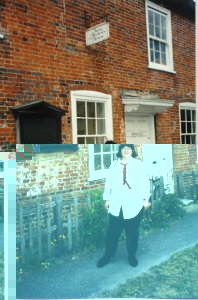 Our first day in England was
full of Jane Austen. We spent the morning in Chawton. The
"Jane Austen House" , the farm bailiff’s cottage
provided by Jane’s Brother Edward for Jane, her sister and
mother after death of their father, is now owned and administered
by the Jane Austen Memorial Trust. The house does not contain
many furnishings, but does have the small writing table at which
Jane wrote. There is also a very small pianoforte. The glass
fronted cabinets contain first editions of the novels as well as
editions of "Lovers’ Vows" and "Elegant
Extracts". The topaz crosses given by Charles Austen to Jane
and Cassandra are on display along with other artifacts including
one of Jane Austen’s manuscript music books. There are
photocopies of Jane’s letters and of her will on the walls.
In the upstairs corridor, the wall is hung with drawings by Hugh
Thompson published in the 1894 edition of Pride and Prejudice.
There is little furniture in Jane and Cassandra’s room, but
a patchwork quilt made by Jane, Cassandra and their mother, is
displayed on one wall. The visit was very touching and a bit
melancholy.
Our first day in England was
full of Jane Austen. We spent the morning in Chawton. The
"Jane Austen House" , the farm bailiff’s cottage
provided by Jane’s Brother Edward for Jane, her sister and
mother after death of their father, is now owned and administered
by the Jane Austen Memorial Trust. The house does not contain
many furnishings, but does have the small writing table at which
Jane wrote. There is also a very small pianoforte. The glass
fronted cabinets contain first editions of the novels as well as
editions of "Lovers’ Vows" and "Elegant
Extracts". The topaz crosses given by Charles Austen to Jane
and Cassandra are on display along with other artifacts including
one of Jane Austen’s manuscript music books. There are
photocopies of Jane’s letters and of her will on the walls.
In the upstairs corridor, the wall is hung with drawings by Hugh
Thompson published in the 1894 edition of Pride and Prejudice.
There is little furniture in Jane and Cassandra’s room, but
a patchwork quilt made by Jane, Cassandra and their mother, is
displayed on one wall. The visit was very touching and a bit
melancholy.
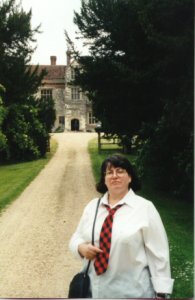 When we left the cottage, we
walked down the road to Chawton House, the seat of the estate
owned by Edward Knight. The house is not open to the public, but
is being restored to house the Centre for the Study of Early English
Women's Writing(chawton@aol.com).
Fortunately, we had an introduction to Cassie Knight, a direct
descendent of Edward, and so a great….great niece of Jane.
Cassie is working with an American organization to restore the
house and kindly showed us the work they were doing and talked to
us about her family and our trip. She gave us the liberty of the
estate and we spent some time walking the grounds and talking
about what it must have been like 187 years ago.
When we left the cottage, we
walked down the road to Chawton House, the seat of the estate
owned by Edward Knight. The house is not open to the public, but
is being restored to house the Centre for the Study of Early English
Women's Writing(chawton@aol.com).
Fortunately, we had an introduction to Cassie Knight, a direct
descendent of Edward, and so a great….great niece of Jane.
Cassie is working with an American organization to restore the
house and kindly showed us the work they were doing and talked to
us about her family and our trip. She gave us the liberty of the
estate and we spent some time walking the grounds and talking
about what it must have been like 187 years ago.
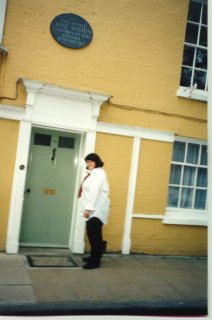 Our next stop was Winchester.
We walked the grounds of the Cathedral College and found the
house on College Street where Cassandra took Jane during her last
days so that she might be under the care of a doctor. This is the
house where Jane Austen died. From there, we went to Winchester
Cathedral and visited Jane. There is the stone, placed at
Jane’s burial in the cathedral floor. There is also a brass
plaque and a stained glass window given in her memory.
Our next stop was Winchester.
We walked the grounds of the Cathedral College and found the
house on College Street where Cassandra took Jane during her last
days so that she might be under the care of a doctor. This is the
house where Jane Austen died. From there, we went to Winchester
Cathedral and visited Jane. There is the stone, placed at
Jane’s burial in the cathedral floor. There is also a brass
plaque and a stained glass window given in her memory.
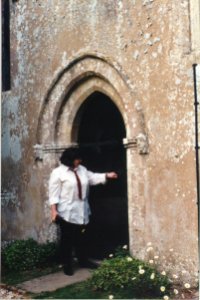 After tea, we drove to
Steventon over roads that would not admit two cars. There were
spaces along the side of the road so one car could pull over if
two should be approaching each other. St. Nicholas’ Church
is in a place that probably discourages much tourist traffic. We
were greeted by a very agreeable dog who wanted us to play with
him rather than visit the church. The church, itself, was closed,
but we wandered the yard and found the graves of Jane’s
brother James and, presumably, his wife as well as various other
Knight relatives.
After tea, we drove to
Steventon over roads that would not admit two cars. There were
spaces along the side of the road so one car could pull over if
two should be approaching each other. St. Nicholas’ Church
is in a place that probably discourages much tourist traffic. We
were greeted by a very agreeable dog who wanted us to play with
him rather than visit the church. The church, itself, was closed,
but we wandered the yard and found the graves of Jane’s
brother James and, presumably, his wife as well as various other
Knight relatives.
Tuesday, June
3, 1997
We started today at
Stonehenge (no pictures - I’m sure you’ve seen it). We
were among the first there and thank God for that. It became
extremely crowded even as we were leaving. It is an eerie site,
surrounded by the burial mounds, barrows and artifacts of
earlier, bigger installations.
It was a short drive
to Wilton, the estate of the Earl of Pembroke and one that has
been used in many movies, as the Earl is, apparently, himself a
director. There was a small Jane Austen exhibit which included
some extremely tiny costumes from Sense and Sensibility. I was
especially struck by how small Kate Winslet’s dress was,
although Emma Thompson’s was not much bigger. The London
Ball scene in Sense and Sensibility was filmed in the Double Cube
room at Wilton. It is a gorgeous room, recently restored, with an
incredible ceiling, as have most of the public rooms at Wilton.
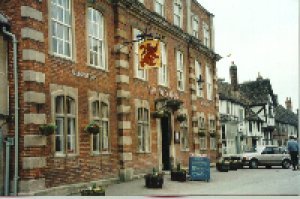 Our next stop was to have been
Lyme Regis. But the sky was overcast and Lyme was a detour from
our ultimate destination. Instead we went to Lacock. It is, of
course, very like Meryton, as the only differences are the shop
windows, the paved roads and the cars parked everywhere. Although
the National Trust owns the entire village, there are tenants in
most of the buildings. They are, naturally, parked in front of
their homes. The buildings are charming and, some, decrepit. We
walked the entire village, which is mostly residential. I’m
sure the influx of Austen related tourism must be driving the
residents bats.
Our next stop was to have been
Lyme Regis. But the sky was overcast and Lyme was a detour from
our ultimate destination. Instead we went to Lacock. It is, of
course, very like Meryton, as the only differences are the shop
windows, the paved roads and the cars parked everywhere. Although
the National Trust owns the entire village, there are tenants in
most of the buildings. They are, naturally, parked in front of
their homes. The buildings are charming and, some, decrepit. We
walked the entire village, which is mostly residential. I’m
sure the influx of Austen related tourism must be driving the
residents bats.
From Lacock to Bath,
a place that welcomes tourism with open arms and seems to have
done so for centuries. Our first stop was the Roman baths. I had
been here on my last trip, but the antiquity of the place and its
history never fails to move me. I would have stopped for tea in
the Pump Room (which I had done before), but my companions were
eager to sight see. We walked to the Circus and Royal Crescent
and stopped for a glass of wine on a small side street lined with
used book stores.
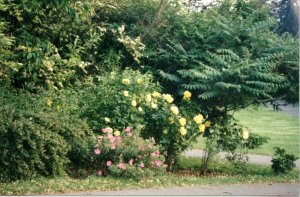
Our hotel was was
only three blocks from Sydney Place, the Austen’s first home
in Bath. We easily found #4 Sydney Place. It has been turned into
apartments. The bells have names beside each floor: The sign by
the top floor bell read "Amy & Guy". The sign by
the second floor bell read "Pride & Badger". For
some reason, this tickled me. I’m still looking for someone
who understands this reaction. We walked through Sydney Gardens,
across the street from the house. It is quite lovely. We had our
first good meal of the trip in Bath. It was in a little
restaurant off High Street called Moon and Sixpence. I
immediately thought of Amy when we found it.
Wednesday,
June 4, 1997
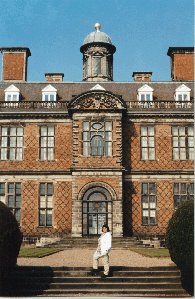 After breakfast, we walked to
the Assembly Rooms, stopping first at some used book stores. I
found a Jane Austen Trivia book which I bought for Las Vegas. The
Assembly Rooms are lovely. They were bombed during WWII and have
been restored to their original condition. The costume museum in
the basement has recently been damaged by flood, but the exhibits
are still quite wonderful. There are many fine examples of dress
from 16th Century to the present. We
After breakfast, we walked to
the Assembly Rooms, stopping first at some used book stores. I
found a Jane Austen Trivia book which I bought for Las Vegas. The
Assembly Rooms are lovely. They were bombed during WWII and have
been restored to their original condition. The costume museum in
the basement has recently been damaged by flood, but the exhibits
are still quite wonderful. There are many fine examples of dress
from 16th Century to the present. We 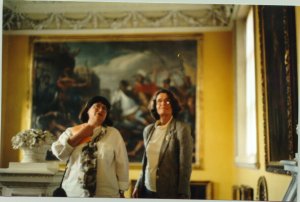 stopped at the Bath building
museum on our return to the hotel.
stopped at the Bath building
museum on our return to the hotel.
We drove through the
Cotswolds and reached Sudbury in mid-afternoon, in time for a
tour of the hall. The exterior is lovely and quite imposing, but
it was the interior we came to see. Although photography is
forbidden inside National Trust sites, Dan managed to sneak a few
of the salon (Pemberley music room), the staircase, the portrait
gallery and the door to the Queen’s bedroom (Darcy’s
room).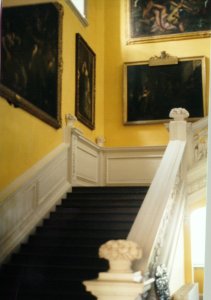
There was an exhibit
from Pride and Prejudice on the upper floors. This included
correspondence arranging for the use of the hall, some script
pages, publicity shots and candid photos (including one of
Jennifer Ehle in costume wearing a huge hair net and smoking a
cigarette). Some of the P&P costumes were also on exhibit:
Mrs. Hurst’s orange number, a Mrs. Bennet dress, Mr.
Bingley’s wedding clothes, Elizabeth’s muslin gown with
the floral print and her wedding dress.
This night, I
discovered that there are two Sudburys in England and I had made
our hotel reservations in the one in Suffolk (oh!). We
backtracked to Lichfield and, fortunately, found a lovely place
to spend the night.
Thursday,
June 5, 1997
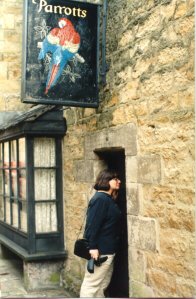 We headed north again after
breakfast. The change in landscape as you enter the Peaks
District is remarkable. The land quickly becomes craggy and steep
and the sides of the road rise to gorges. The roads are
incredibly narrow and some of the driving was rather scary. We
managed to wend our way to Longnor (quite possibly the first
tourists to do so). Longnor (Lambton) seems from another time
altogether. The couple in the local store left the store
completely unattended to take us around the corner to the Parrot
which was used as the Lambton Inn. We came away with fresh baked
bread, Stilton (a local product) and some wonderful pictures. We
had also managed to amuse the natives with our search for Jane.
We headed north again after
breakfast. The change in landscape as you enter the Peaks
District is remarkable. The land quickly becomes craggy and steep
and the sides of the road rise to gorges. The roads are
incredibly narrow and some of the driving was rather scary. We
managed to wend our way to Longnor (quite possibly the first
tourists to do so). Longnor (Lambton) seems from another time
altogether. The couple in the local store left the store
completely unattended to take us around the corner to the Parrot
which was used as the Lambton Inn. We came away with fresh baked
bread, Stilton (a local product) and some wonderful pictures. We
had also managed to amuse the natives with our search for Jane.
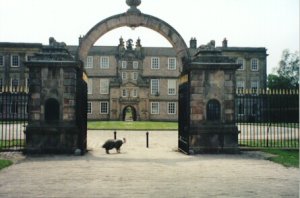 On to Pemberley. Lyme Park is
wonderful. This was probably the most beautiful place we visited.
The park itself is 1700 acres. The house was closed, but we
walked the courtyard and the gardens. We walked up what Cheryl
calls the "Thighmaster Steps" and I took some pictures
for her. We also took pictures on the steps in the courtyard,
from the hill in front of the building and, of course, the
classic picture across the pond in the back.
On to Pemberley. Lyme Park is
wonderful. This was probably the most beautiful place we visited.
The park itself is 1700 acres. The house was closed, but we
walked the courtyard and the gardens. We walked up what Cheryl
calls the "Thighmaster Steps" and I took some pictures
for her. We also took pictures on the steps in the courtyard,
from the hill in front of the building and, of course, the
classic picture across the pond in the back.
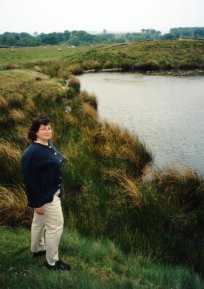 The Trust has mapped out
"The Pemberley Trail" which covers a lot of territory.
The walk begins up the hill to where Darcy arrives on horseback
and around a paddock to a tiny path leading to "The
Pond".
The Trust has mapped out
"The Pemberley Trail" which covers a lot of territory.
The walk begins up the hill to where Darcy arrives on horseback
and around a paddock to a tiny path leading to "The
Pond". 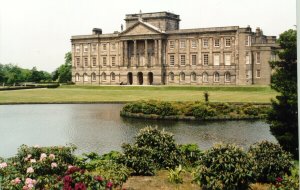
The grounds are
extraordinary. One could spend days exploring. "A low
phaeton with a nice little pair of ponies would be the very
thing." The formal gardens are not extensive, but very
lovely and include an elegant orangerie. The park has more
gorgeous rhododendrons than I have ever seen anywhere.
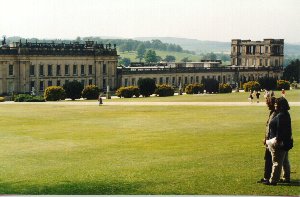 After our hike, we left for
Chatsworth. It is rumored, of course, that this is the house on
which Jane Austen modeled Pemberley. In it’s present state,
it is a prime example of egregious ostentation. It has been
over-improved to a Disney-like state. Some parts were wonderful.
The Lupine garden took my breath away, but much of it was greatly
overdone. The main house itself could easily have stood as a
model for Pemberley, I suppose, but the subsequent additions have
done nothing to improve it.
After our hike, we left for
Chatsworth. It is rumored, of course, that this is the house on
which Jane Austen modeled Pemberley. In it’s present state,
it is a prime example of egregious ostentation. It has been
over-improved to a Disney-like state. Some parts were wonderful.
The Lupine garden took my breath away, but much of it was greatly
overdone. The main house itself could easily have stood as a
model for Pemberley, I suppose, but the subsequent additions have
done nothing to improve it.
Friday, June
6, 1997
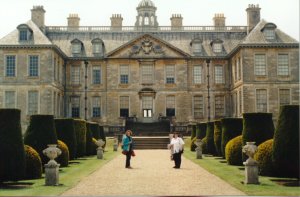 We spent the night in Grantham
in an inn built originally for the Knights Templar (it has since
been updated). In the morning, we headed for Belton House
(Rosings). The house itself did not open until 1:00, so we walked
the grounds and took some pictures. This is another lovely home
now owned by the National Trust. It was very soothing after the
overindulgence of Chatsworth.
We spent the night in Grantham
in an inn built originally for the Knights Templar (it has since
been updated). In the morning, we headed for Belton House
(Rosings). The house itself did not open until 1:00, so we walked
the grounds and took some pictures. This is another lovely home
now owned by the National Trust. It was very soothing after the
overindulgence of Chatsworth.
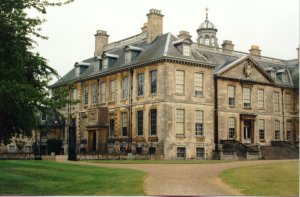 We had a picnic on the lawn
and then went into the house. I would have loved to have some
pictures from inside Belton. The staircase was, itself, worth the
trip. However, unlike Sudbury, this one had wardens in every room
to prevent such deviant behavior as photography. We saw the blue
room, which was Darcy’s room at Rosings and is, as you all
suspected, on the first floor.
We had a picnic on the lawn
and then went into the house. I would have loved to have some
pictures from inside Belton. The staircase was, itself, worth the
trip. However, unlike Sudbury, this one had wardens in every room
to prevent such deviant behavior as photography. We saw the blue
room, which was Darcy’s room at Rosings and is, as you all
suspected, on the first floor.
We climbed that
extraordinary staircase and made the circuit of the second floor.
The rooms open here include the one occupied by the Duke of
Windsor during his visits to Belton. This room is papered in
specially made wall paper. When the paper was delivered, there
was not enough to paper the entire room, so they had the room
made smaller… Another feature of the tour was the suite
occupied by the current Prince of Wales during his RAF days.
Downstairs again, we
saw the dining room (used as the Rosings drawing room), painted a
very dark green and every spare inch of wall covered with huge
bird murals. Also open was a smaller anteroom, used as the music
room in Rosings. The warden in the room told us, "This is
where Liz played the piano, isn’t it?"
On the way to our
hotel that evening, we followed the signs to Sulgrave Manor on a
whim and ended up at the ancestral home of George Washington.
This was much less grand than the places we had been seeing and
was an interesting counterpoint to the immersion in
Britain’s peerage which we have had this week.
Saturday,
June 7, 1997
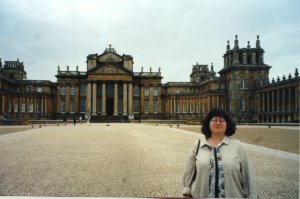 Blenheim Palace this morning.
It is a magnificent building and no disappointment after seeing
Hamlet. The interior is also extraordinary. It is hard to
conceive of the wealth and longevity of family required to
maintain the residences we have seen on this trip. Some have
dealt with this, like the Duke of Marlborough, by opening their
homes to the public and essentially turning their grounds into
theme parks and movie sets. Others have turned them over to the
National Trust to be preserved.
Blenheim Palace this morning.
It is a magnificent building and no disappointment after seeing
Hamlet. The interior is also extraordinary. It is hard to
conceive of the wealth and longevity of family required to
maintain the residences we have seen on this trip. Some have
dealt with this, like the Duke of Marlborough, by opening their
homes to the public and essentially turning their grounds into
theme parks and movie sets. Others have turned them over to the
National Trust to be preserved.
After a picnic on the
grounds, we went to Oxford, which turned out to be a
disappointment. I had Peter Wimsey’s Oxford in my mind and
it certainly was not to be found outside the walls of the
colleges. And all the colleges that allowed visitors, were
charging admission. We had gone without a real object and,
outside of the colleges, Oxford could easily have been Cambridge,
Massachusetts (except for its age).
Sunday June
8, 1997
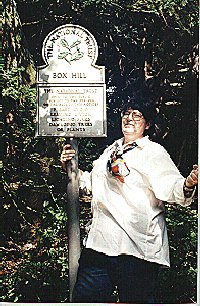 My last day. Our flight did
not leave until afternoon, so we found Box Hill and climbed far
enough to know we were not going to the top. We drove to Greater
Bookham and ended up at the midpoint of the London to Brighton
Classic Car Rally. A nice 20th century end to our search for Jane
Austen.
My last day. Our flight did
not leave until afternoon, so we found Box Hill and climbed far
enough to know we were not going to the top. We drove to Greater
Bookham and ended up at the midpoint of the London to Brighton
Classic Car Rally. A nice 20th century end to our search for Jane
Austen.
I leave you all with
some of the images I imagine you most wanted me to bring back
from this trip.
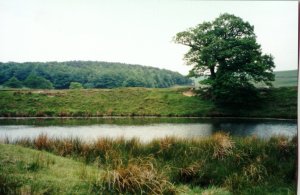
Thanks for joining
me.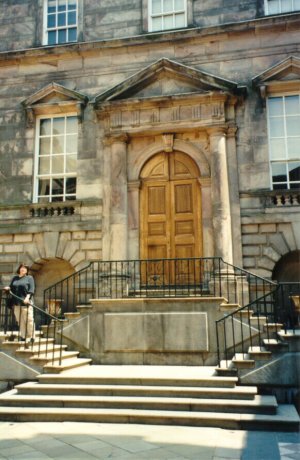 The trip was as wonderful as
I had hoped and the thought of bringing these memories back to
all of you made it even more special.
The trip was as wonderful as
I had hoped and the thought of bringing these memories back to
all of you made it even more special.
 Our first day in England was
full of Jane Austen. We spent the morning in Chawton. The
"Jane Austen House" , the farm bailiff’s cottage
provided by Jane’s Brother Edward for Jane, her sister and
mother after death of their father, is now owned and administered
by the Jane Austen Memorial Trust. The house does not contain
many furnishings, but does have the small writing table at which
Jane wrote. There is also a very small pianoforte. The glass
fronted cabinets contain first editions of the novels as well as
editions of "Lovers’ Vows" and "Elegant
Extracts". The topaz crosses given by Charles Austen to Jane
and Cassandra are on display along with other artifacts including
one of Jane Austen’s manuscript music books. There are
photocopies of Jane’s letters and of her will on the walls.
In the upstairs corridor, the wall is hung with drawings by Hugh
Thompson published in the 1894 edition of Pride and Prejudice.
There is little furniture in Jane and Cassandra’s room, but
a patchwork quilt made by Jane, Cassandra and their mother, is
displayed on one wall. The visit was very touching and a bit
melancholy.
Our first day in England was
full of Jane Austen. We spent the morning in Chawton. The
"Jane Austen House" , the farm bailiff’s cottage
provided by Jane’s Brother Edward for Jane, her sister and
mother after death of their father, is now owned and administered
by the Jane Austen Memorial Trust. The house does not contain
many furnishings, but does have the small writing table at which
Jane wrote. There is also a very small pianoforte. The glass
fronted cabinets contain first editions of the novels as well as
editions of "Lovers’ Vows" and "Elegant
Extracts". The topaz crosses given by Charles Austen to Jane
and Cassandra are on display along with other artifacts including
one of Jane Austen’s manuscript music books. There are
photocopies of Jane’s letters and of her will on the walls.
In the upstairs corridor, the wall is hung with drawings by Hugh
Thompson published in the 1894 edition of Pride and Prejudice.
There is little furniture in Jane and Cassandra’s room, but
a patchwork quilt made by Jane, Cassandra and their mother, is
displayed on one wall. The visit was very touching and a bit
melancholy.  When we left the cottage, we
walked down the road to Chawton House, the seat of the estate
owned by Edward Knight. The house is not open to the public, but
is being restored to house the Centre for the Study of Early English
Women's Writing(chawton@aol.com).
Fortunately, we had an introduction to Cassie Knight, a direct
descendent of Edward, and so a great….great niece of Jane.
Cassie is working with an American organization to restore the
house and kindly showed us the work they were doing and talked to
us about her family and our trip. She gave us the liberty of the
estate and we spent some time walking the grounds and talking
about what it must have been like 187 years ago.
When we left the cottage, we
walked down the road to Chawton House, the seat of the estate
owned by Edward Knight. The house is not open to the public, but
is being restored to house the Centre for the Study of Early English
Women's Writing(chawton@aol.com).
Fortunately, we had an introduction to Cassie Knight, a direct
descendent of Edward, and so a great….great niece of Jane.
Cassie is working with an American organization to restore the
house and kindly showed us the work they were doing and talked to
us about her family and our trip. She gave us the liberty of the
estate and we spent some time walking the grounds and talking
about what it must have been like 187 years ago.  Our next stop was Winchester.
We walked the grounds of the Cathedral College and found the
house on College Street where Cassandra took Jane during her last
days so that she might be under the care of a doctor. This is the
house where Jane Austen died. From there, we went to Winchester
Cathedral and visited Jane. There is the stone, placed at
Jane’s burial in the cathedral floor. There is also a brass
plaque and a stained glass window given in her memory.
Our next stop was Winchester.
We walked the grounds of the Cathedral College and found the
house on College Street where Cassandra took Jane during her last
days so that she might be under the care of a doctor. This is the
house where Jane Austen died. From there, we went to Winchester
Cathedral and visited Jane. There is the stone, placed at
Jane’s burial in the cathedral floor. There is also a brass
plaque and a stained glass window given in her memory.  After tea, we drove to
Steventon over roads that would not admit two cars. There were
spaces along the side of the road so one car could pull over if
two should be approaching each other. St. Nicholas’ Church
is in a place that probably discourages much tourist traffic. We
were greeted by a very agreeable dog who wanted us to play with
him rather than visit the church. The church, itself, was closed,
but we wandered the yard and found the graves of Jane’s
brother James and, presumably, his wife as well as various other
Knight relatives.
After tea, we drove to
Steventon over roads that would not admit two cars. There were
spaces along the side of the road so one car could pull over if
two should be approaching each other. St. Nicholas’ Church
is in a place that probably discourages much tourist traffic. We
were greeted by a very agreeable dog who wanted us to play with
him rather than visit the church. The church, itself, was closed,
but we wandered the yard and found the graves of Jane’s
brother James and, presumably, his wife as well as various other
Knight relatives. Our next stop was to have been
Lyme Regis. But the sky was overcast and Lyme was a detour from
our ultimate destination. Instead we went to Lacock. It is, of
course, very like Meryton, as the only differences are the shop
windows, the paved roads and the cars parked everywhere. Although
the National Trust owns the entire village, there are tenants in
most of the buildings. They are, naturally, parked in front of
their homes. The buildings are charming and, some, decrepit. We
walked the entire village, which is mostly residential. I’m
sure the influx of Austen related tourism must be driving the
residents bats.
Our next stop was to have been
Lyme Regis. But the sky was overcast and Lyme was a detour from
our ultimate destination. Instead we went to Lacock. It is, of
course, very like Meryton, as the only differences are the shop
windows, the paved roads and the cars parked everywhere. Although
the National Trust owns the entire village, there are tenants in
most of the buildings. They are, naturally, parked in front of
their homes. The buildings are charming and, some, decrepit. We
walked the entire village, which is mostly residential. I’m
sure the influx of Austen related tourism must be driving the
residents bats.
 After breakfast, we walked to
the Assembly Rooms, stopping first at some used book stores. I
found a Jane Austen Trivia book which I bought for Las Vegas. The
Assembly Rooms are lovely. They were bombed during WWII and have
been restored to their original condition. The costume museum in
the basement has recently been damaged by flood, but the exhibits
are still quite wonderful. There are many fine examples of dress
from 16th Century to the present. We
After breakfast, we walked to
the Assembly Rooms, stopping first at some used book stores. I
found a Jane Austen Trivia book which I bought for Las Vegas. The
Assembly Rooms are lovely. They were bombed during WWII and have
been restored to their original condition. The costume museum in
the basement has recently been damaged by flood, but the exhibits
are still quite wonderful. There are many fine examples of dress
from 16th Century to the present. We  stopped at the Bath building
museum on our return to the hotel.
stopped at the Bath building
museum on our return to the hotel.
 We headed north again after
breakfast. The change in landscape as you enter the Peaks
District is remarkable. The land quickly becomes craggy and steep
and the sides of the road rise to gorges. The roads are
incredibly narrow and some of the driving was rather scary. We
managed to wend our way to Longnor (quite possibly the first
tourists to do so). Longnor (Lambton) seems from another time
altogether. The couple in the local store left the store
completely unattended to take us around the corner to the Parrot
which was used as the Lambton Inn. We came away with fresh baked
bread, Stilton (a local product) and some wonderful pictures. We
had also managed to amuse the natives with our search for Jane.
We headed north again after
breakfast. The change in landscape as you enter the Peaks
District is remarkable. The land quickly becomes craggy and steep
and the sides of the road rise to gorges. The roads are
incredibly narrow and some of the driving was rather scary. We
managed to wend our way to Longnor (quite possibly the first
tourists to do so). Longnor (Lambton) seems from another time
altogether. The couple in the local store left the store
completely unattended to take us around the corner to the Parrot
which was used as the Lambton Inn. We came away with fresh baked
bread, Stilton (a local product) and some wonderful pictures. We
had also managed to amuse the natives with our search for Jane. On to Pemberley. Lyme Park is
wonderful. This was probably the most beautiful place we visited.
The park itself is 1700 acres. The house was closed, but we
walked the courtyard and the gardens. We walked up what Cheryl
calls the "Thighmaster Steps" and I took some pictures
for her. We also took pictures on the steps in the courtyard,
from the hill in front of the building and, of course, the
classic picture across the pond in the back.
On to Pemberley. Lyme Park is
wonderful. This was probably the most beautiful place we visited.
The park itself is 1700 acres. The house was closed, but we
walked the courtyard and the gardens. We walked up what Cheryl
calls the "Thighmaster Steps" and I took some pictures
for her. We also took pictures on the steps in the courtyard,
from the hill in front of the building and, of course, the
classic picture across the pond in the back. The Trust has mapped out
"The Pemberley Trail" which covers a lot of territory.
The walk begins up the hill to where Darcy arrives on horseback
and around a paddock to a tiny path leading to "The
Pond".
The Trust has mapped out
"The Pemberley Trail" which covers a lot of territory.
The walk begins up the hill to where Darcy arrives on horseback
and around a paddock to a tiny path leading to "The
Pond". 
 After our hike, we left for
Chatsworth. It is rumored, of course, that this is the house on
which Jane Austen modeled Pemberley. In it’s present state,
it is a prime example of egregious ostentation. It has been
over-improved to a Disney-like state. Some parts were wonderful.
The Lupine garden took my breath away, but much of it was greatly
overdone. The main house itself could easily have stood as a
model for Pemberley, I suppose, but the subsequent additions have
done nothing to improve it.
After our hike, we left for
Chatsworth. It is rumored, of course, that this is the house on
which Jane Austen modeled Pemberley. In it’s present state,
it is a prime example of egregious ostentation. It has been
over-improved to a Disney-like state. Some parts were wonderful.
The Lupine garden took my breath away, but much of it was greatly
overdone. The main house itself could easily have stood as a
model for Pemberley, I suppose, but the subsequent additions have
done nothing to improve it. We spent the night in Grantham
in an inn built originally for the Knights Templar (it has since
been updated). In the morning, we headed for Belton House
(Rosings). The house itself did not open until 1:00, so we walked
the grounds and took some pictures. This is another lovely home
now owned by the National Trust. It was very soothing after the
overindulgence of Chatsworth.
We spent the night in Grantham
in an inn built originally for the Knights Templar (it has since
been updated). In the morning, we headed for Belton House
(Rosings). The house itself did not open until 1:00, so we walked
the grounds and took some pictures. This is another lovely home
now owned by the National Trust. It was very soothing after the
overindulgence of Chatsworth.  We had a picnic on the lawn
and then went into the house. I would have loved to have some
pictures from inside Belton. The staircase was, itself, worth the
trip. However, unlike Sudbury, this one had wardens in every room
to prevent such deviant behavior as photography. We saw the blue
room, which was Darcy’s room at Rosings and is, as you all
suspected, on the first floor.
We had a picnic on the lawn
and then went into the house. I would have loved to have some
pictures from inside Belton. The staircase was, itself, worth the
trip. However, unlike Sudbury, this one had wardens in every room
to prevent such deviant behavior as photography. We saw the blue
room, which was Darcy’s room at Rosings and is, as you all
suspected, on the first floor.  Blenheim Palace this morning.
It is a magnificent building and no disappointment after seeing
Hamlet. The interior is also extraordinary. It is hard to
conceive of the wealth and longevity of family required to
maintain the residences we have seen on this trip. Some have
dealt with this, like the Duke of Marlborough, by opening their
homes to the public and essentially turning their grounds into
theme parks and movie sets. Others have turned them over to the
National Trust to be preserved.
Blenheim Palace this morning.
It is a magnificent building and no disappointment after seeing
Hamlet. The interior is also extraordinary. It is hard to
conceive of the wealth and longevity of family required to
maintain the residences we have seen on this trip. Some have
dealt with this, like the Duke of Marlborough, by opening their
homes to the public and essentially turning their grounds into
theme parks and movie sets. Others have turned them over to the
National Trust to be preserved. My last day. Our flight did
not leave until afternoon, so we found Box Hill and climbed far
enough to know we were not going to the top. We drove to Greater
Bookham and ended up at the midpoint of the London to Brighton
Classic Car Rally. A nice 20th century end to our search for Jane
Austen.
My last day. Our flight did
not leave until afternoon, so we found Box Hill and climbed far
enough to know we were not going to the top. We drove to Greater
Bookham and ended up at the midpoint of the London to Brighton
Classic Car Rally. A nice 20th century end to our search for Jane
Austen. 
 The trip was as wonderful as
I had hoped and the thought of bringing these memories back to
all of you made it even more special.
The trip was as wonderful as
I had hoped and the thought of bringing these memories back to
all of you made it even more special.